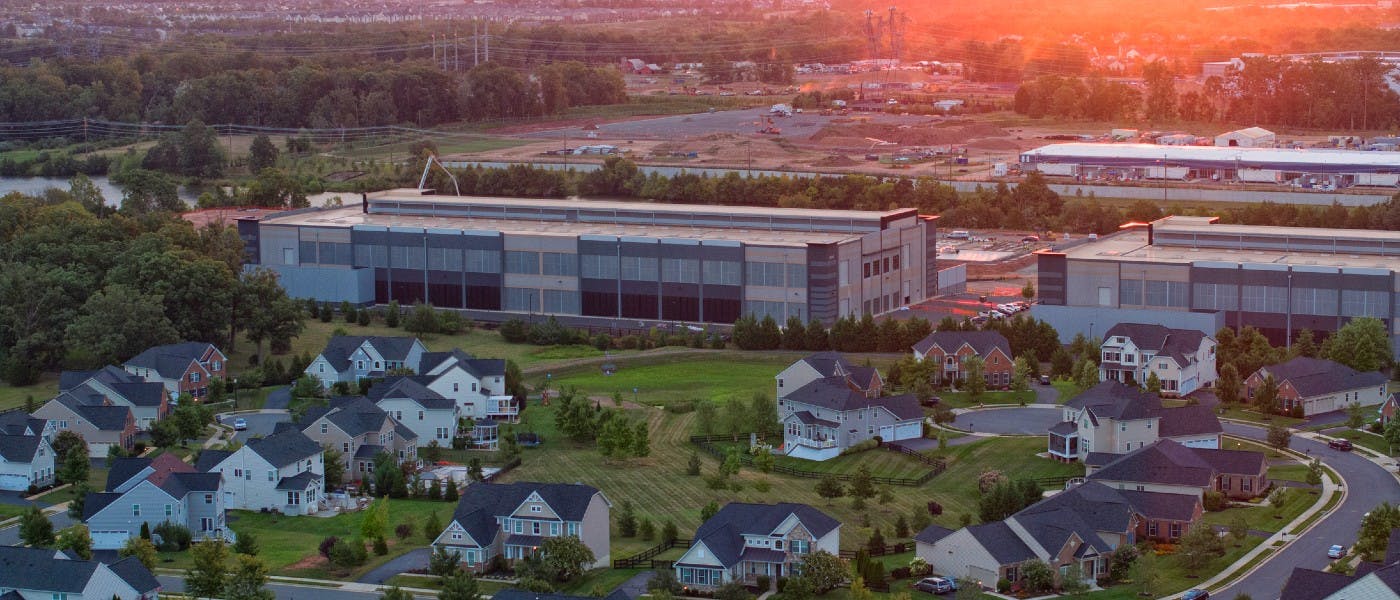Data centers have become an integral part of the digital age. Unfortunately, many communities realize they are loud, resource-intensive, and visually unappealing only after they’ve been built. Are these buildings neighborhood-ruiners, or are peoples’ concerns overblown?
Are Data Centers Already Ruining Neighborhoods?
The residents of the sleepy, tree-lined subdivision of Great Oak didn’t realize what was in store for them when construction began for an Amazon Web Services (AWS) data center. This small community in Prince William County, Virginia, soon became the epicenter of an ongoing quarrel between a multinational tech giant and a local homeowners association.
Dale Browne, the president of the Great Oak Homeowners Association, said the building’s “constant whir” was “obnoxious” and
Others didn’t object to the building’s construction or operation. While some saw it as an innovative move, others were apathetic because their once-rural oasis had already become a minimetropolis. After all, what’s one data center among highways, power lines, and supersized shopping centers?
Still, many residents were unhappy seeing these massive server warehouses pop up nearby. In the neighboring Loudoun County, companies have built them
Why Are Data Centers Popping up Everywhere?
Data centers are proliferating despite pockets of concern. The artificial intelligence market — which experts expect
Whether companies train a machine learning model or store 8K videos on cloud servers, they need data centers. While data center proliferation has been on the rise for years, it only became a well-known point of contention recently when AI’s popularity prompted firms to reinvest in server warehouses.
Why are data centers being built in Virginia? Decision-makers are quickly making this state the so-called “data center capital of the world” for good reason. While some counties are inviting tech companies in hopes of inspiring a second Silicon Valley, others are just in convenient locations — the
How These Buildings Impact Nearby Neighborhoods
Why are people against data centers? One of the public’s biggest complaints is noise — many don’t realize how loud these buildings are until they live next to one. Other common concerns include resource usage, greenhouse gas emissions, traffic congestion, and potential pollution.
Water Drainage
Cooling a massive warehouse packed to the brim with servers, routers, storage systems, and processors takes a lot of water. Research shows one large data center can use up
Noise Pollution
Many data centers have on-site generators. Their cooling systems — essential for keeping hardware operational — contain intake and exhaust fans, which are objectionably loud. They
Are data centers noisy at night? Most are since they run around the clock. Even if their volume doesn’t increase after hours, their loudness is more noticeable when it gets quiet. People often describe the noise as a buzzing, tinny whining or low-pitched roar. Even 60 dB — the low end of the typical spectrum — sounds like overlapping conversations or background music.
Power Depletion
Do data centers use a lot of energy? They are among the most energy-intensive buildings in existence, consuming
The Implications of Having a Data Center Nearby
Many people are concerned about having a structure that constantly produces 55-85 dB in their backyards — and for good reason. How loud is a data center? While 60 dB
There is also concern about intense resource usage. In Maryland, a
The health of local communities and ecosystems may also be at stake. If data centers use generators for on-site power, they could produce toxic pollutants like nitrogen oxide or diesel exhaust. The cooling system’s noise alone could drive local wildlife away, damaging environmentally sensitive areas.
Counties that initially welcomed large technology and cloud computing companies with open arms have wavered after realizing how loud and resource-intensive these structures are. Many may soon raise taxes on hardware, revise their noise ordinances, or enforce strict project review processes to make it worthwhile.
Are Communities’ Data Center Fears Justified?
The worst-case scenario is using 5 million gallons of water, outputting 85 dB, and producing toxic diesel exhaust daily. That said, most data centers will be noisy and resource-intensive. Air cooling is loud but standard,
The Great Oak Homeowners Association is an excellent example of this fact. While Amazon initially denied the residents’ claims its building was outputting 60 dB — even going as far as to
One year after the spat between the AWS data centers and the Great Oak community made headlines, Amazon lengthened its exhaust tubes and directed airflow vertically. Measurements from it and the Homeowners Association revealed the noise level
Currently, it seems decision-makers aren’t considering the long-term repercussions of building near neighborhoods — they’re quickly seizing whatever land is cheap and available. To ease communities’ fears, they should consider their projects’ long-term viability, accounting for how construction and operation will affect nearby residents and local ecosystems.
When considering all of the negatives in a vacuum, data centers sound like one of the worst structures a company could ever build. However, they support essential services and help connect people around the world. Most of today’s problems are growing pains — now that engineers and operators know what not to do, they can build better or retrofit existing buildings.
For example, while air cooling generates significant noise, immersion cooling — which involves submerging hardware in a non-conductive liquid —
What Companies and Communities Can Do Going Forward
Gathering and implementing feedback is the only way to permanently ease communities’ concerns. This strategy may even pay off for technology companies because it streamlines site research and lets them know what interventions to prioritize. For example, if people worry about unsightly power lines but don’t care about noise, firms only need to build on-site power.











